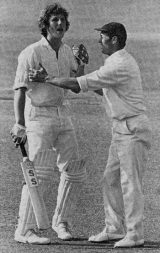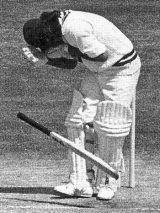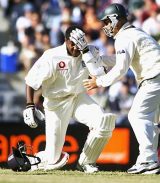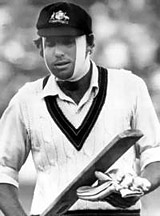More dangerous games
Another selection of moments where batsmen came off second best to fast bowlers

Phil Simmons was a promising rookie opener with two Tests under his belt when West Indies arrived in England for their 1988 tour. His opportunities were destined to be limited, given that Greenidge and Haynes were firmly ensconced as the Test opening partnership, but he had managed 55 against Hampshire in his first outing of the tour, and followed up with another half-century in gloomy conditions at Bristol, when he was struck on the temple by England's fast-bowling prospect, David Lawrence. Simmons had not been wearing a helmet, and his heart had actually stopped beating as he was rushed to Frenchay hospital for emergency brain surgery. Miraculously, Simmons made a full recovery, and was fit and focused enough to take his place for all five Tests of West Indies' next tour of England in 1991. Lawrence, meanwhile, managed to remain unaffected by the drama, and made his Test debut against Sri Lanka three months later.
|
|

|
The 18-year-old Ian Botham had already been making headlines when Somerset faced Hampshire in a Benson & Hedges Cup quarter-final. At 113 for 8 chasing 182, Somerset appeared down and out before Botham started to hit out. Andy Roberts, at the time one of the fastest bowlers in the world and reputed to possess the most deadly bouncer, dug one in and struck Botham a fearful blow in the mouth. Bleeding and groggy and deprived of several teeth, he composed himself, making 45 not out and cracking the boundary which sealed a one-wicket win. The following summer Roberts laid out Colin Cowdrey.
Nothing riled the great West Indian fast bowlers quite like a successful run-chase, as Bishan Bedi's Indians discovered to their cost at Kingston in April 1976. One match on from India's successful pursuit of 403 for victory at Port-of-Spain, West Indies sensed an opportunity for vengeance, and claimed it with both hands in one of the most brutal muggings the game has ever seen. Already lacking two batsmen after Aunshuman Gaekwad and Brijesh Patel were felled in the first innings, Bedi saw fit to declare at just five wickets down, after a calculated assault on what remained of India's decimated batting order. West Indies eased to their series-winning target of 13 with ten wickets in hand, whereupon Clive Lloyd defended his tactics, saying: "you can't expect us to bowl half-volleys".
|
|

|
The era in which tailenders were given a gentle ride was drawing to a close thanks to the emergence of helmets - only two years earlier the ICC had instructed captains to tell their bowlers that "the short-pitched ball should in no circumstances bowled at non-recognised batsmen". But the final nail in the coffin came in the first Test of 1978 when Bob Willis, bowling round the wicket to the right hand Iqbal Qasim, felled him with a brutish short delivery. He came in with five minutes left on the third day and was greeted in the first over of the fourth, also bowled by Willis, with a ball which the Times said "parted his hair". Qasim was a genuine bunny and the incident made headlines because Willis, not the most outwardly emotional character, showed no concern for the bleeding batsman. "The incident showed the umpires at their weakest, the England captain at his most indifferent and the bowler at his most callous," wrote John Woodcock in the Times. Ten days earlier, Tony Greig had given an interview to the Australian entitled "Blood and bouncers to keep the crowd happy." The cat was well and truly out of the bag.
When Bert Sutcliffe was floored by a bouncer from Neil Adcock which split his ear early in his innings at Johannesburg, he was carted off to hospital and few expected him to take any further part in the match. But with his side in deep trouble on 81 for 6 - Adcock also caused Lawrie Miller to spit blood after being hit in the chest - he returned, heavily bandaged and pale, to score 80 not out in a total of 187, adding 33 for the last wicket with fast bowler Bob Blair in a partnership charged with emotion and sympathy for the New Zealanders. Two days earlier, on Christmas Eve, Blair's 19-year-old fiancée had been one of 151 people killed in a rail accident in New Zealand. However, many believed that Sutcliffe was never the same batsman following the blow.
|
|

|
Australia's Ashes supremacy throughout the 1990s and early 2000s was all encompassing, but few moments summed up the differences between the sides quite so succinctly as Brett Lee's felling of Alex Tudor at Perth in December 2002. England's bottle had quite simply vanished in the days leading up to the incident - they were about to surrender the Ashes in a mere 11 days - but by the time Lee was let loose on a lightning-quick WACA pitch, their stomach for the fight had evaporated. A first-innings deficit of 271 didn't encourage the batsmen to hang around at the crease, but Lee by now was bowling like the wind, and Tudor, in his first and last match of the series, had no place to hide. A short ball followed him all the way from wrist to forehead, and Tudor collapsed at the crease with a massive welt forming over his eye. Almost four years have passed, and he hasn't played for England again.
It wasn't a first-class match, but how many of us have wished to deck a prime minister? That's what happened to Australia's cricket-mad PM Bob Hawke, 53, when he was struck in the face during a match against the country's media by the Herald's Gary O'Neill. Hawke, who had played first-grade cricket in Sydney in his youth, had his glasses smashed and had to have glass fragments removed from around his eye. Although he retired hurt on 28, he gamely returned to see his side home. Proving the game is not for the faint-hearted, Labour party secretary Bob McMullen was later carted off with concussion after missing the ball while going for a catch in the deep.
|
|

|
The opening exchanges of the Centenary Test were overshadowed by a dreadful injury sustained by Rick McCosker when he deflected a Bob Willis bouncer into his face. Concussed, he was led to the dressing-room where the team doctor pronounced it was nothing serious. Two hours later, McCosker, whose condition had deteriorated, was rushed to hospital where his jaw was found to be broken in two places. On the fourth day, with the match evenly poised, Greg Chappell asked McCosker to bat, and with his head swathed in bandages, with his Baggy Green perched precariously on top and his jaw wired, he played one of the most courageous innings of the modern era. Batting at No. 10, he added 54 with Rod Marsh, a partnership which ultimately exceeded the 45-run winning margin.
This injury has similarities with the McCosker incident, in that both sustained a broken jaw and both returned to action, bandaged to the hilt. But while McCosker's heroics were with the bat, Kumble's were with the ball. "Sheathed in head bandages like some battle-front survivor, he returned to the action on the third evening with a broken jaw," recounted Wisden. "It had just been announced that he was flying home for surgery, but when he saw Sachin Tendulkar turning the ball he hurried out, went straight into the attack, and bowled 14 consecutive overs, in which he dismissed Brian Lara and had Carl Hooper caught off a no-ball. Only the close of play halted him; next day, he departed." He had been hit by Merv Dillon after being promoted to No.7, and as a result was peppered with bouncers, one of which struck him as he turned away. He continued batting for another 20 minutes.
The one where the batsman bit back. Devon Malcolm was one of life's gentler giants, and one of the most inept No. 11 batsmen of them all, but woe betide any team that dared to rile him. The South Africans discovered this to their cost in the decisive third Test in 1994, when an ill-advised bouncer from Fanie de Villiers triggered one of the most ferocious ripostes in history. The badge of St George on Malcolm's helmet was sent spinning towards gully as he was struck flush on the forehead, and as he dusted himself and prepared to take strike once again, he reportedly muttered to anyone within earshot: "You guys are history". He was true to his word. Steaming into the breach, he removed both Kirsten brothers and Hansie Cronje in the space of three overs, and bowled like the wind throughout his 16.3 overs to return the remarkable figures of 9 for 57. Having led by 28 on first innings, a shellshocked South Africa were bundled out for 175, and England cantered to victory by eight wickets to secure a share of the series.
Martin Williamson is managing editor of Cricinfo, Andrew Miller is UK editor